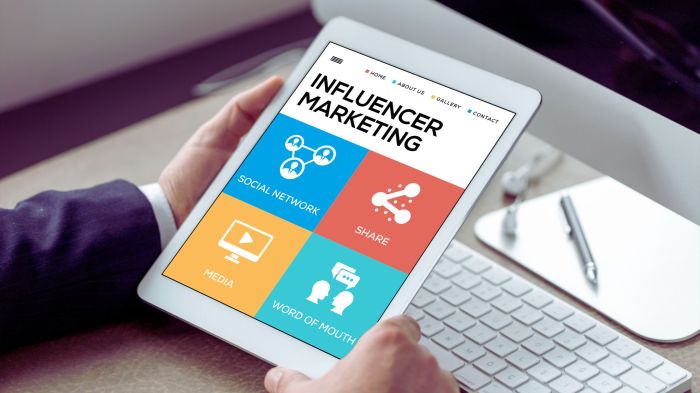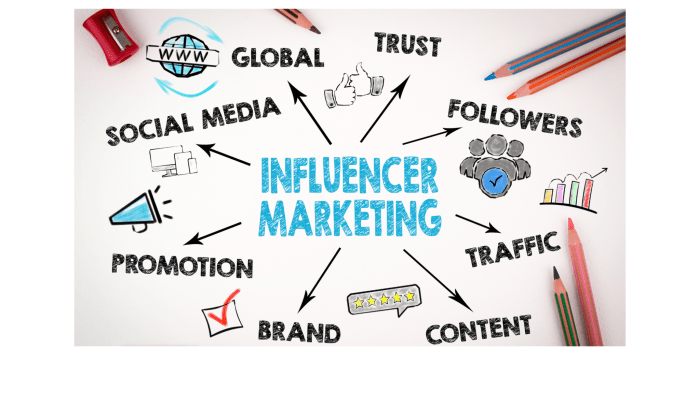Building an Influencer Marketing Campaign takes center stage, inviting you into a world of modern marketing strategies. Get ready to dive into the realm of influencer marketing and its impact on businesses!
Whether you’re a budding entrepreneur or a seasoned marketer, understanding how to leverage influencers can be a game-changer in today’s competitive landscape.
Overview of Influencer Marketing Campaigns

Influencer marketing campaigns are a strategic approach where businesses collaborate with individuals who have a significant following on social media platforms to promote their products or services. These influencers have the power to sway the opinions and purchasing decisions of their followers, making them valuable assets for brands looking to increase their reach and engagement.
Importance of Influencer Marketing
In today’s digital landscape, where traditional advertising methods are becoming less effective, influencer marketing has emerged as a powerful tool for businesses to connect with their target audience authentically. By partnering with influencers who have built trust and credibility with their followers, brands can tap into a highly engaged audience and achieve higher levels of brand awareness and customer loyalty.
- Increased Reach: Influencers have a loyal and engaged following, allowing brands to reach a broader audience that may be difficult to target through traditional advertising.
- Authenticity and Trust: Influencers are seen as relatable figures by their followers, making their product recommendations more trustworthy and authentic compared to traditional ads.
- Improved Engagement: Influencer marketing campaigns often lead to higher levels of engagement, as followers are more likely to interact with content that is endorsed by someone they trust.
- Targeted Marketing: Businesses can work with influencers whose audience aligns with their target demographic, ensuring that their message reaches the right people.
Setting Campaign Objectives
When it comes to setting up your influencer marketing campaign, you gotta be SMART about it. And no, I don’t mean just being clever – I mean setting Specific, Measurable, Achievable, Relevant, and Time-bound objectives. This means you need to have clear goals in mind that you can track and evaluate throughout the campaign.
Setting SMART Objectives
- Specific: Your objectives need to be well-defined and clear. For example, instead of saying “increase brand awareness,” you could say “increase brand awareness by 20% among millennials.”
- Measurable: Make sure you can track and measure your objectives. This could be through metrics like engagement rates, website traffic, or sales conversions.
- Achievable: Your objectives should be realistic and attainable based on your resources and capabilities. Setting unrealistic goals can lead to disappointment.
- Relevant: Your objectives should align with your overall marketing goals and be relevant to your target audience and brand positioning.
- Time-bound: Set a specific timeframe for achieving your objectives. This could be within a month, a quarter, or a year, depending on the scope of your campaign.
Aligning Campaign Objectives with Marketing Goals
To ensure that your influencer marketing campaign objectives are in sync with your overall marketing goals, you need to take a step back and look at the big picture. Consider how your campaign fits into your marketing strategy and what specific role influencers will play in achieving those goals. For example, if your marketing goal is to increase online sales by 30% in the next quarter, your influencer campaign objective could be to drive a specific percentage of that increase through influencer collaborations.
Common Objectives for Influencer Marketing Campaigns
- Increase Brand Awareness: Introduce your brand to a new audience or increase visibility among your target demographic.
- Boost Engagement: Encourage likes, comments, shares, and other interactions with your brand or products.
- Drive Traffic: Direct followers to your website, landing page, or social media profiles to increase visits and conversions.
- Generate Leads: Collect contact information from potential customers for future marketing efforts.
- Increase Sales: Drive purchases through influencer promotions and collaborations.
Identifying the Right Influencers

When it comes to selecting influencers for your campaign, it’s crucial to find individuals who resonate with your brand’s values and speak to your target audience. Here are some key criteria to consider:
Macro, Micro, and Nano Influencers, Building an Influencer Marketing Campaign
- Macro Influencers: These are influencers with a large following, typically over 100,000 followers. They are well-known and can reach a wide audience, making them ideal for brand awareness campaigns.
- Micro Influencers: With followers ranging from 10,000 to 100,000, micro influencers have a more niche audience. They often have higher engagement rates and can be more cost-effective for targeted campaigns.
- Nano Influencers: Nano influencers have a smaller following, usually under 10,000, but they have a highly engaged and loyal audience. They are great for building authenticity and trust with a specific community.
Researching and Vetting Influencers
- Look for influencers whose values align with your brand’s mission and image. Check their past collaborations and content to ensure they are a good fit.
- Analyze their engagement rates and audience demographics to see if they match your target market. Quality over quantity is key.
- Consider using influencer marketing platforms to find and connect with influencers. These tools can help streamline the vetting process and provide valuable insights.
Crafting Compelling Campaign Content: Building An Influencer Marketing Campaign
When it comes to creating engaging content for influencer marketing campaigns, there are a few key steps to keep in mind. First and foremost, understanding the target audience and tailoring the content to their preferences is crucial. Additionally, incorporating authenticity and storytelling into the content can greatly enhance its impact and resonance with viewers.
Importance of Authenticity and Storytelling
Authenticity is key in influencer marketing campaigns as it helps build trust and credibility with the audience. When influencers share genuine experiences and opinions, it resonates more with viewers and can lead to higher engagement levels. Storytelling, on the other hand, helps create a narrative around the product or service being promoted, making it more relatable and memorable for the audience.
- Authenticity: Influencers should be encouraged to share personal stories and experiences related to the brand or product to establish a genuine connection with their followers.
- Storytelling: Crafting a narrative around the product can help create an emotional connection with the audience, making the content more engaging and impactful.
- Visual Content: Incorporating high-quality images and videos can help capture the audience’s attention and enhance the overall storytelling experience.
Successful Influencer Marketing Campaign Content Strategies
One great example of a successful influencer marketing campaign content strategy is the use of user-generated content. By encouraging followers to create and share their own content featuring the product or service, brands can leverage the power of social proof and authenticity to attract more customers.
Another effective strategy is collaborating with influencers who have a strong personal brand and a loyal following. These influencers can create content that seamlessly integrates the brand into their everyday lives, making it feel more natural and organic.
Measuring Campaign Performance
When it comes to evaluating the success of influencer marketing campaigns, it is crucial to track key performance indicators (KPIs) that can provide valuable insights into the campaign’s effectiveness.
Key Performance Indicators (KPIs)
Here are some essential KPIs to consider when measuring the performance of your influencer marketing campaign:
- Engagement Rate: Monitor likes, comments, shares, and overall interaction with the content to gauge audience engagement.
- Reach and Impressions: Measure the number of people who have seen the content shared by the influencer.
- Conversion Rate: Track the number of conversions such as website visits, sign-ups, or purchases directly attributed to the campaign.
- Brand Sentiment: Analyze the overall sentiment surrounding your brand before and after the campaign to assess any changes in perception.
Tracking and Analyzing Campaign Performance
Utilize various tools and methods to effectively track and analyze campaign performance metrics:
- Use social media analytics tools like Sprout Social, Hootsuite, or Buffer to monitor engagement, reach, and other relevant metrics.
- Implement UTM parameters to track traffic and conversions from influencer-generated content to your website.
- Utilize Google Analytics to analyze website traffic, user behavior, and conversions attributed to the influencer campaign.
Interpreting Data for Optimization
After collecting data on the campaign performance, it is essential to interpret the results to optimize future influencer marketing strategies:
- Identify trends and patterns in the data to understand what resonates most with your target audience.
- Adjust your content strategy based on the performance of different influencers and types of content.
- Experiment with new approaches and tactics based on the insights gained from the data analysis.
